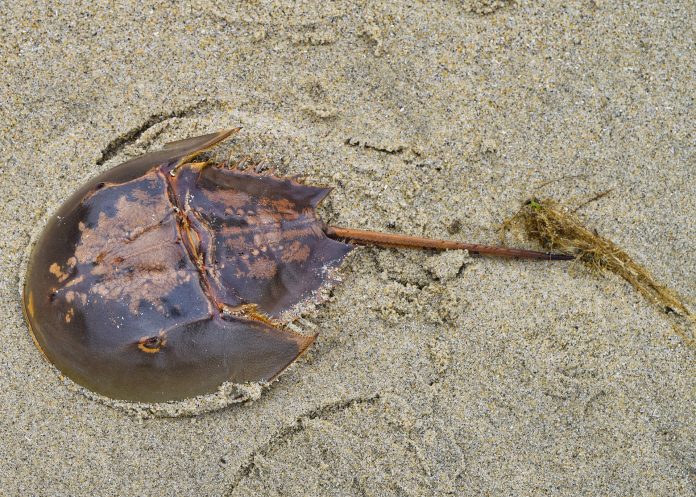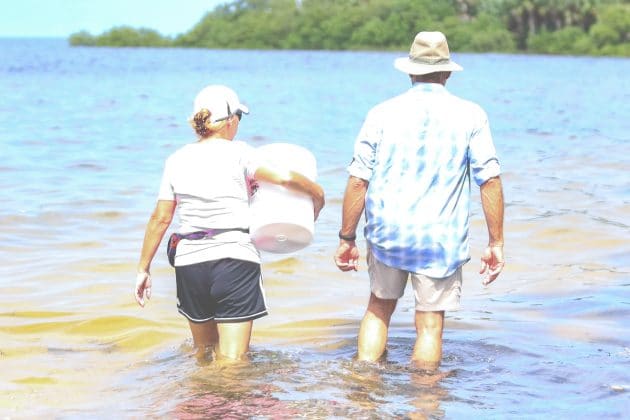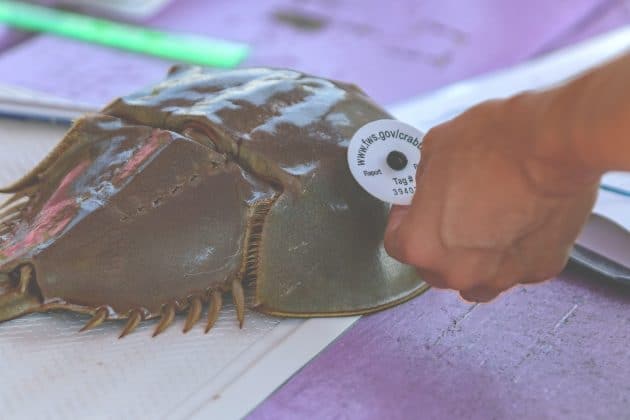Have you ever wondered how many bees visit a single sunflower? Or do you like gazing at the clouds and ever thought you could help NASA scientists identify cloud types, cloud cover, and even the sky color? Citizen Science Month is held annually in April and is a month-long collaboration during which volunteers, new or seasoned, help with a wide variety of citizen science projects. These projects help many researchers, biologists, and conservationists collect essential data. Thousands of citizens (volunteers) participate in these scientific research and monitoring projects. By giving their time and dedication, those participating are getting the best opportunity to learn about the environment and conservation.
The Horseshoe Crab Watch citizen science project has been conducted in Hernando County over the past four years. This project led by UF/IFAS Sea Grant Agent Brittany Hall-Scharf helps biologists collect essential data on horseshoe crabs during mating season. Often when people encounter horseshoe crabs along the beach, they will confuse them for a stingray. This is rightly so, because they do have long tails. But unlike stingrays, horseshoe crabs are not venomous. They are not going to hurt you. The tail of the horseshoe crab helps it to flip over. So, if a wave comes and flips it upside down, the horseshoe crab can then use this tail to flip right side up.
Did you know these ancient, odd-looking creatures are essential to humans and the environment? Researchers worldwide are using the horseshoe crab’s unique blue blood to ensure that the COVID-19 vaccine is safe for us to administer. Scientists have been using horseshoe crab blood since the 1970s to check vaccines and equipment for contamination. Before the 1970s, patients would come down with “injection fever” when they received a shot. Sometimes these patients would recover, but they would often become very sick and die.
Unfortunately, information about these superheroes in Florida is lacking. We need to learn more about them to ensure they continue to survive for many years to come. We want to learn more about how many males vs. females are out there, where the crabs travel to, whether they use the same beach for nesting year after year, what environmental stimuli trigger them to nest, and many other questions! We call our statewide team of volunteers citizen-scientists. This requires the scientists I work with to rely on volunteers to help us collect valuable information. They are a vital contributor to the Florida Horseshoe Crab Watch program.
Volunteers on this team are trained to walk specific beaches when the tides and moon are right. They go out in groups with buckets and look for horseshoe crabs nesting in Hernando’s marine sandy and shallow areas. When volunteers find horseshoe crabs, they pick up the nesting pair and put them in 5-gallon buckets. Volunteers carry these crabs to the shore to collect more information about each crab. The volunteers place a plastic tag on their shells. It is the white circle on the left side of the crab. This tag has a unique number on it, think of it as a farmer placing a tag in the ear of one of his cattle. It lets them know the specific ID for that cow, we do that for crabs. That identification number lets us know if we ever recapture that crab where it was initially tagged and maybe where it went.
Although it will take us a few more years of collecting data, the information that this citizen-science program is collecting has already been used in a stock assessment by the Atlantic States marine fisheries commission, which is a deliberative body that has representatives from each one of the Atlantic coast states that work together to promote habitat conservation, fishery science, fisheries management, and law enforcement. Data from this program also informs other management agencies around the state, like the Florida Fish and Wildlife Conservation Commission.
Tagging horseshoe crabs is essential, but reporting horseshoe crab sightings is important. We need lots of volunteers to help us. if you go out on the beach and you do see one of these tagged superheroes, there are a few simple steps you can follow that will gives us some great information:
1) Snap a picture of the tag or record the tag number. Do not remove the tag from the horseshoe crab.
2) Note the horseshoe crab’s date, location, and general condition.
3) Report the data using the online form (www.fws.gov/crabtag) or by calling 1-888-546-8587.
If a horseshoe crab is flipped upside-down, please do not pick it up by its tail, which is harmful to the animal. Instead, gently place both hands on the sides of the horseshoe crab and return the animal to the upright position.
There are more citizen science opportunities for those who may be interested in future projects. Check out: Citizen Science – UF/IFAS Extension (ufl.edu) and SciStarter.org



